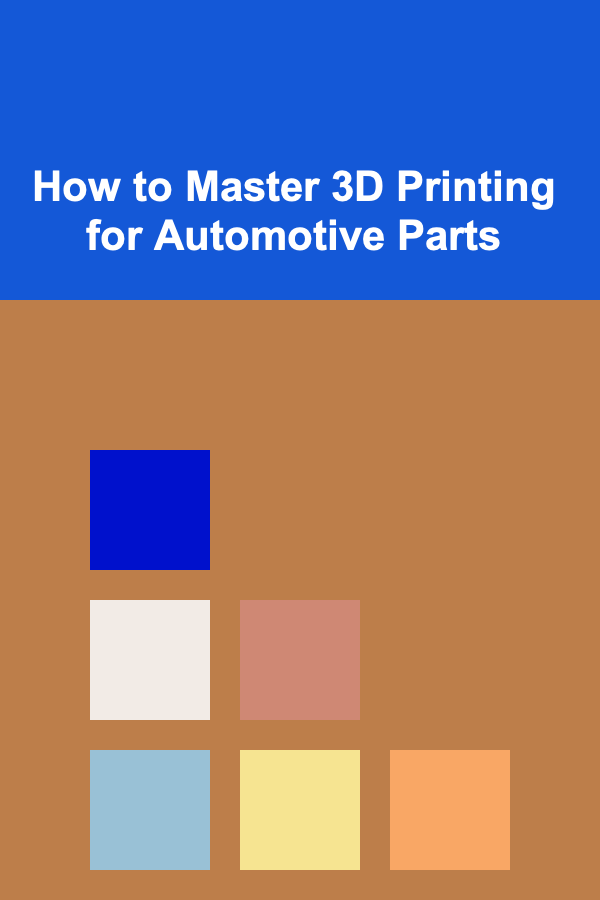
How to Master 3D Printing for Automotive Parts
ebook include PDF & Audio bundle (Micro Guide)
$12.99$11.99
Limited Time Offer! Order within the next:

The evolution of 3D printing, also known as additive manufacturing, has introduced numerous innovative opportunities across industries, one of the most promising being automotive manufacturing. As the automotive sector embraces this technology, companies and individuals are discovering its potential to revolutionize the design, production, and repair of car parts. In this article, we will explore how to master 3D printing for automotive parts, delving into its applications, challenges, and strategies for success in this rapidly growing field.
The Significance of 3D Printing in Automotive Manufacturing
3D printing has disrupted traditional manufacturing processes by offering a more efficient, flexible, and cost-effective approach. In the automotive industry, this means the ability to quickly prototype, customize, and even produce functional parts. 3D printing allows manufacturers to create complex geometries that were once difficult or impossible to achieve using traditional methods like injection molding or machining.
Automakers are beginning to see the immense value in leveraging 3D printing technology to:
- Rapidly prototype new designs
- Customize parts for specific needs or vehicles
- Reduce material waste by using only the necessary amount of material
- Shorten lead times by producing parts on demand
- Lower costs for low-volume production runs and spare parts
The integration of 3D printing technology into automotive manufacturing is not just a trend; it's a strategic move that enhances competitiveness and sustainability. However, mastering this technology requires a comprehensive understanding of the principles of 3D printing, the materials involved, and the automotive design requirements.
Step 1: Understanding the Basics of 3D Printing Technology
Before diving into 3D printing for automotive parts, it's crucial to understand how 3D printing works. Additive manufacturing involves building an object layer by layer based on a digital model. The primary technologies used in 3D printing for automotive applications include:
1.1. Fused Deposition Modeling (FDM)
FDM is one of the most commonly used 3D printing methods. It involves heating and extruding a filament of plastic material, which is deposited layer by layer to create the desired part. FDM is often used for prototyping and producing functional parts made of thermoplastics like ABS, PLA, and nylon. It's well-suited for automotive applications such as dashboards, brackets, and non-structural components.
1.2. Selective Laser Sintering (SLS)
SLS uses a laser to fuse small particles of plastic, metal, or ceramic powder into a solid structure. The laser selectively melts the powder to form each layer, and the process is repeated until the part is complete. SLS is capable of producing strong, durable parts and is often used for creating functional components, including interior car parts and engine components. The versatility of materials in SLS makes it a top choice for producing custom automotive parts.
1.3. Stereolithography (SLA)
SLA uses a laser to cure a liquid resin layer by layer to build a solid part. SLA produces parts with high precision and smooth surface finishes, making it ideal for prototype parts where fine detail is important. Though not typically used for functional automotive parts due to its material limitations, SLA is excellent for creating intricate designs, exterior trim parts, and conceptual models.
1.4. Direct Metal Laser Sintering (DMLS)
DMLS is a metal 3D printing technique that uses a laser to fuse metal powder together. It is particularly valuable for creating durable, high-strength automotive parts that require precise geometries, such as engine components, exhaust systems, and structural supports. DMLS enables manufacturers to reduce part weight and complexity, resulting in enhanced performance and reduced material waste.
Step 2: Choosing the Right Materials for Automotive Parts
One of the most important considerations when mastering 3D printing for automotive parts is selecting the appropriate materials. Automotive parts require durability, strength, and heat resistance, and not all 3D printing materials are suitable for such applications. Let's explore some of the most commonly used materials in 3D printing for the automotive industry:
2.1. Thermoplastics
Thermoplastics are versatile, lightweight, and cost-effective materials commonly used in 3D printing. They are typically used for producing prototypes and non-structural automotive parts. Common thermoplastics include:
- ABS (Acrylonitrile Butadiene Styrene): Known for its strength and impact resistance, ABS is commonly used for functional automotive parts such as interior components and housings.
- Nylon: This flexible, durable material is ideal for creating strong, wear-resistant parts like gears, brackets, and connectors.
- Polycarbonate (PC): This material offers high strength, heat resistance, and transparency, making it suitable for applications such as automotive lenses and light housings.
2.2. Metal Alloys
For parts that require strength, durability, and heat resistance, metal 3D printing is a viable solution. Automotive manufacturers can use metal 3D printing for producing high-performance components such as engine parts, exhaust systems, and structural elements. Common metal alloys used in automotive 3D printing include:
- Stainless Steel: Known for its corrosion resistance and strength, stainless steel is commonly used for functional parts and prototypes.
- Titanium: Titanium is ideal for parts that require strength-to-weight ratios, such as engine components and lightweight structural parts.
- Aluminum: Aluminum alloys are used for lightweight automotive components such as chassis and engine parts due to their strength and thermal conductivity.
2.3. Composites
Composite materials, which combine two or more materials with distinct properties, are increasingly used in automotive applications. Carbon fiber composites, for example, are used for creating lightweight and high-strength components. These materials offer enhanced performance while reducing vehicle weight, which improves fuel efficiency and handling.
2.4. Resins
For applications where high precision and surface finish are crucial, resins are often used. Photopolymer resins, such as those used in SLA, can provide smooth finishes and high detail. Though not as durable as thermoplastics or metals, they are suitable for prototype parts, automotive accessories, and decorative components.
Step 3: Designing Automotive Parts for 3D Printing
The design phase plays a critical role in mastering 3D printing for automotive parts. Unlike traditional manufacturing methods, 3D printing offers greater freedom to design complex shapes, optimize geometries, and reduce material waste. However, there are specific design principles to keep in mind when designing parts for 3D printing.
3.1. Design for Additive Manufacturing (DfAM)
Design for Additive Manufacturing (DfAM) refers to designing parts specifically for 3D printing rather than adapting traditional designs. DfAM allows designers to leverage the unique capabilities of 3D printing, such as producing complex internal geometries and organic shapes. Some key DfAM principles include:
- Complexity for free: 3D printing enables the production of highly intricate designs without additional cost. Designers can create parts with complex internal structures, lattice designs, or organic shapes that would be difficult or impossible to achieve with traditional manufacturing methods.
- Lightweight structures: 3D printing allows the creation of lightweight yet strong parts by using honeycomb or lattice structures. This is particularly beneficial in the automotive industry, where weight reduction can improve performance and fuel efficiency.
- Customization: 3D printing allows for the customization of automotive parts to fit specific vehicles, models, or customer preferences, making it ideal for aftermarket parts, accessories, and limited production runs.
3.2. Tolerances and Material Properties
While 3D printing offers exceptional design flexibility, it's important to consider the tolerances of 3D printing machines and the material properties. Unlike traditional manufacturing methods, 3D printing may result in slight inaccuracies in part dimensions, so it's essential to account for these variations in your design. Additionally, the material properties of the 3D printed parts should be considered to ensure they meet the required strength, thermal resistance, and durability for automotive applications.
3.3. Post-Processing
Post-processing is often required to improve the surface finish, remove support structures, and enhance the mechanical properties of 3D printed parts. Techniques such as sanding, polishing, heat treatment, and coating can be used to ensure that the final part meets automotive standards.
Step 4: Prototyping and Testing 3D Printed Automotive Parts
Once the design is finalized, 3D printing can be used for prototyping and testing parts before full-scale production. This iterative process allows manufacturers to validate designs, assess functionality, and make necessary adjustments before committing to expensive traditional manufacturing processes.
4.1. Rapid Prototyping
Rapid prototyping with 3D printing enables automotive engineers to quickly produce prototypes of new parts and test their form, fit, and function. This significantly reduces the time required for product development and allows for faster iteration, enabling manufacturers to bring new designs to market more quickly.
4.2. Functional Testing
In addition to visual and mechanical testing, functional testing is essential for automotive parts. Parts produced via 3D printing can be subjected to various stress tests, including heat resistance, vibration testing, and durability under load. This ensures that 3D printed automotive parts can perform reliably in real-world conditions.
Step 5: Overcoming Challenges in 3D Printing for Automotive Parts
Despite the many benefits of 3D printing, there are challenges that automotive manufacturers must address to fully harness its potential.
5.1. Material Limitations
While 3D printing offers a wide range of materials, there are still limitations in terms of material strength, durability, and heat resistance. Certain automotive components, such as engine blocks or transmission parts, require materials that can withstand extreme conditions, which may not always be achievable with current 3D printing technologies.
5.2. Cost Considerations
Although 3D printing can be cost-effective for prototyping and low-volume production, the initial investment in 3D printing equipment and materials can be high. Moreover, the costs associated with post-processing and quality control must be considered when calculating the overall cost of 3D printing for automotive parts.
5.3. Scale and Speed
While 3D printing is excellent for low-volume production, scaling up to mass production is still a challenge. Traditional manufacturing methods, such as injection molding or stamping, are more efficient and cost-effective for producing large quantities of parts. However, ongoing advancements in 3D printing technology may eventually overcome these limitations.
Conclusion
Mastering 3D printing for automotive parts is an exciting and transformative journey. By understanding the different 3D printing technologies, selecting the right materials, designing with additive manufacturing in mind, and navigating challenges such as material limitations and cost, automotive manufacturers can leverage 3D printing to create innovative, customized, and cost-effective parts.
As 3D printing technology continues to evolve, its role in the automotive industry will only grow, enabling faster production times, reduced costs, and a more sustainable approach to manufacturing. Those who master this technology will be at the forefront of a revolution in automotive design and manufacturing.

How to Find Niche Markets for Selling Used Books Online: An Actionable Guide
Read More
Optimizing Logistics: Strategies and Best Practices for Transportation Coordinators
Read More
What Techniques Can Help You Organize Your Home's Focal Points?
Read More
How to Find Budget-Friendly Camping Spots
Read More
How To Edit Your Content Like a Pro
Read More
How To Protect Your Financial Data Online
Read MoreOther Products

How to Find Niche Markets for Selling Used Books Online: An Actionable Guide
Read More
Optimizing Logistics: Strategies and Best Practices for Transportation Coordinators
Read More
What Techniques Can Help You Organize Your Home's Focal Points?
Read More
How to Find Budget-Friendly Camping Spots
Read More
How To Edit Your Content Like a Pro
Read More